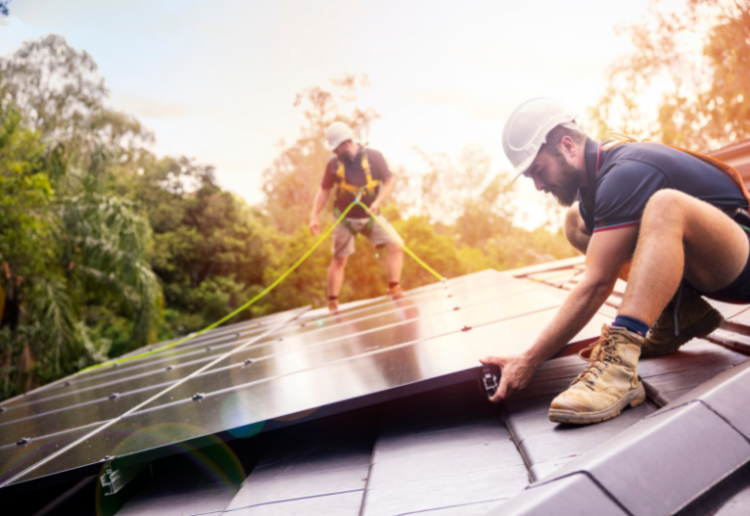One of the most effective ways for Australian families to get a handle on rising energy bills is by installing a solar power system – and it’s made all the more financially attractive thanks to government renewable power incentives.
Solar incentives are a way to help recoup the cost of setting up and maintaining a rooftop solar and battery system – and millions of Aussies have taken advantage of both federal and state-based incentives.
If you’re not sure how solar rebates work, or how much you can save, we’ve consulted the experts at Australia’s leading name in solar since 1953 – Solahart, to walk us through what’s available.
Federal Government Solar Incentives
Nationally, under a federal government legislated scheme, individuals and businesses are provided a financial incentive to install small-scale renewable energy systems (like rooftop PV solar, solar water heaters and heat pumps) through the Small-scale Renewable Energy Scheme (SRES). The incentive is to help with the purchase cost of the system.
Once an eligible system is installed, Small-Scale Technology Certificates (STCs) are created, which are then sold to electricity retailers who are required to surrender these to the government under this scheme. The financial benefit to the Owner of the system is the recouping of some of the cost of purchasing and installing the system. This benefit is generally provided as a point of sale discount on the supply and installation of the system, or paid to the Owner shortly after the installation once the STCs have been created. The STCs are provided up front for what your system’s expected electricity generation is for a PV system or electricity displacement is for a solar or heat pump water heater until 2030 when the scheme is due to end.
Solahart General Manager Stephen Cranch encourages families to take advantage of the government initiative and STCs to help reduce the purchase price of a new solar or heat pump system, and save on installation costs.
He explains, “The number of certificates created will vary based on:
- The size and model of the solar or heat pump water heater or PV system you choose.
- The location of the installation (or climate zones).
- The amount of electricity in megawatt-hours (MWh) a rooftop PV system will generate or a solar or heat pump water heater will displace from the time of installation to the end of 2030 when the scheme comes to an end.
- For a solar or heat pump hot water system, each STC represents 1 megawatt-hour (MWh) of electricity displaced until 2030.
- For a solar power system, each STC represents 1 megawatt-hour (MWh) of renewable electricity produced until 2030.
State-Based Solar Incentives
Some Australian states also have their own solar incentives, in addition to the federal government’s STCs. It means families are able to make further savings on the purchase and installation of solar power systems.
New South Wales Energy Savings Scheme (ESS)
The NSW Energy Savings Scheme (ESS) was introduced to make energy-efficient appliances more affordable, via a financial incentive.
Here’s what you need to know, in relation to solar, according to Solahart:
- Solar and heat pump water heaters were included in the scheme in April 2022
- Replace an electric or gas water heater with a renewable alternative, and you may be eligible for a further discount in addition to the STC incentive available under the federal government scheme
- Number of certificates applicable to the installation of a particular system model will be determined by the activity (what the water heater is replacing), and location (postcode)
As Solahart explains, an Accredited Certificate Provider (ACP) then creates the ESCs for the energy savings that will occur and sells them. Like STCs, ESCs can offer a discount on the purchase and installation price of a solar or heat pump water heater.
When is the ESS applicable?
When you replace an existing electric water heater with:
- a heat pump water heater
- a solar (electric-boosted) water heater
When you replace an existing gas water heater with:
- a heat pump water heater
- a solar (electric-boosted) water heater
- a solar (gas-boosted) water heater
Victorian Energy Efficiency Target (VEET)
The Victorian Energy Efficiency Target (VEET) offers Victorian Energy Efficiency Certificates (VEECs) for installing energy-efficient water heaters in place of electric or gas.
- Each certificate represents one tonne of greenhouse gas emissions reduction
- Applies to existing homes
- Works as an additional financial benefit to STCs
When is VEECs applicable?
- When installing 5-star gas, heat pump or solar hot water system in place of an old/inefficient electric water heater
- When installing an efficient 5-star gas or gas-boosted solar water heater in place of an old/inefficient gas water heater
Victorian Solar Panel (PV) Rebate
The Victorian government is also currently providing solar panel rebates of up to $1400 plus the option of an interest-free loan, whether you have an existing home or it’s under construction. The loan needs to be paid off over four years, or can be paid off in a lump sum sooner.
Eligibility criteria includes:
- you must be the owner of an existing property or of a home under construction
- your household has a combined household taxable income of less than $180,000 per year (based on your Australian Tax Office Notice of Assessment)
- you haven’t already received a solar battery rebate or a solar PV rebate under the Solar Homes Program
- you live in an existing property valued at under $3 million, or a home under construction that will be valued at under $3 million at the time of completion
- the property address has not previously received a solar PV or battery rebate
- you do not have an existing solar PV system*.
There’s also a Hot Water Rebate of up to $1000 on eligible heat pumps and hot water systems.
South Australia Retailer Energy Productivity Scheme (REPS)
The Retailer Energy Productivity Scheme (REPS), launched in January 2021, is a South Australian Government initiative that encourages energy retailers to provide incentives for households to make the switch to renewable energy.
- Obliged energy retailers have set annual energy productivity targets they need to meet by providing incentive programs for households and businesses
- Efficient water heaters, like heat pumps and solar hot water systems, are included in REPS
- Examples of REPS initiatives include a discount on services, cash rebates or vouchers
Feed-In Tariffs
On top of the federal and state government solar incentives, you’re also able to make savings via any excess electricity generated by your solar system.
A feed-in tariff is the rate you’re paid for any of the electricity generated by your rooftop solar system that goes back into the grid, because you don’t need it. So your home uses the electricity it needs generated by your solar panels, and you’ll be paid for any excess electricity that’s fed back into the grid.
Again, these vary from state to state in Australia.
Is it a good time to install solar?
Taking into consideration all of the currently available solar incentives, and the rising cost of electricity, you may be wondering if you should make the shift to solar.
“There is no specific good or bad time to install solar,” explains Solahart Product Category Manager Sean Box.
“The government incentivises customers to install solar through their STC (Small-scale technology certificate) program. However, the number of STCs decreases yearly and at the same time, energy prices are going up, so it is fair to say that a good time to install solar is now. The sooner, the better.
“Plus, the sooner you invest in solar, the sooner you’ll reap the benefits of reduced energy bills and help protect yourself from a further increase in energy bills. Adding a solar system to your home will also add value to your home if you’re considering selling in the future.”
If you’re ready to make the switch to solar, get a free quote from the solar experts at Solahart.
Mouths of Mums is proudly working with Solahart to bring you this article. Solahart has built a reputation as a world leader in solar innovation and technology and invested millions of dollars into R&D and manufacturing and installed over 1 million solar water systems in over 70 countries around the world and over 1 million solar panels in Australia alone.






















11:40 am
5:43 pm
8:56 pm
3:50 pm
9:16 pm
4:48 pm
10:00 am
12:46 pm
6:53 am
12:22 pm
10:22 pm
7:25 pm
10:16 am
-

-
-
mom93821 replied
- 09 Aug 2023 , 5:10 am
Reply7:21 am
7:16 am
5:06 am
4:24 am
10:01 pm
9:02 pm
7:09 pm
- 1
- 2
- »
Post a commentTo post a review/comment please join us or login so we can allocate your points.